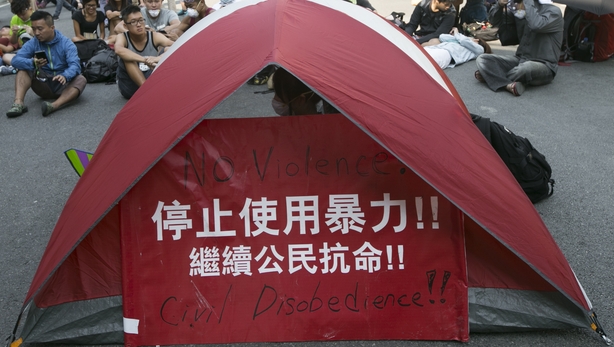Dozens of police removed barricades from a second Hong Kong protest site, following an earlier attempt to clear the edges of the main downtown area occupied by pro-democracy demonstrators for more than two weeks.
Around 150 police officers took away the metal barricades in the bustling Causeway Bay shopping district shortly before dawn, according to an AFP journalist at the scene.
Earlier, hundreds of unidentified people, some wearing masks, tore down barricades amid scuffles with protesters.
Angry taxi drivers opposed to the protests, which have seriously affected their business, rallied at one barricaded road with a row of 12 taxis, demanding an end to the protest.
They had had earlier given protesters a deadline of Wednesday evening for all barricades to be lifted.

A truck with a crane on top attempted to remove barricades from one area until police stopped it.
Hundreds of police had earlier dismantled some barricades to relieve traffic congestion in the Asian financial hub, but said protesters could remain.
But within hours, anti-Occupy Central groups descended on the protest sites to try and disperse demonstrators, taking advantage of the earlier police action to remove barricades.
As scuffles broke out, the first between demonstrators and anti-protest groups, police tried to protect protesters and barricades.
The protesters, mostly students, are demanding full democracy and have called on the city's embattled leader, Leung Chun-ying, to step down after Beijing in August ruled out free elections for Hong Kong's next leader in 2017.
China rules Hong Kong under a "one country, two systems" formula that accords the former British colony a degree of autonomy and freedoms not enjoyed in mainland China, with universal suffrage set as an eventual goal.
The demonstrations escalated late last month after police used tear gas and batons on demonstrators. Since then, police have been largely hands-off and their presence minimal.
Police began removing some barricades today in the areas of Central and Admiralty, home to global financial institutions and government buildings, as well as the bustling district of Mong Kok, across the harbour from the glittering towers of Hong Kong Island.
Many protesters donned face masks and goggles to protect themselves against possible use of tear gas or pepper spray as police, some carrying small riot shields, moved in.
Tensions escalated near the main protest site as nearly 200 mostly elderly, pro-Beijing supporters - wearing blue shirts and ribbons - staged a rally as police stood guard.
The Hong Kong and Beijing governments have called the protests illegal. The Hong Kong government last week called off talks with student leaders.
Yesterday, Mr Leung vowed to remain in office and warned students demanding his resignation that their pro-democracy movement was out of control.
Mr Leung has warned that there was "zero chance" that China's leaders in Beijing would change an August decision limiting democracy in Hong Kong.
The former British colony was promised that its freedoms would be protected under a "one country/two systems" formula, when Britain handed its old colony back to China 17 years ago.
Beijing has said that only candidates screened by a nomination committee will be able to contest a full city-wide vote to choose the next chief executive in 2017.

